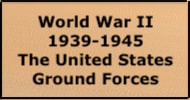bigpigeon.us webpage WWII US > Ground Forces > High-Level Organization, © 2023 by Robert A. Christiansen, updated by RAC 11 Jan 2023.
The high-level organizational structure of US WWII ground forces,
from army group to division, was as follows: Army Group > Army > Corps > Division
The high-level organizational structure of US WWII ground forces,
from army group to division, was as follows: Army Group > Army > Corps > Division
About army groups in WWII:
About armies in WWII:
About corps in WWII:
About divisions in WWII:
Links to lists of army division-size and larger units:
Regarding WWII army infantry divisions:
- First United States Army Group - fake army group in England, led by General George Patton.
- Sixth United States Army Group - army group in the ETO in eastern France, led by General Jacob Devers.
- Twelfth United States Army Group - army group in the ETO, led by General Omar Bradley.
- 15th Army Group - Allied army group in Italy.
- https://en.wikipedia.org/wiki/21st_Army_Group - British army group in the ETO led by General Bernard Montgomery.
About armies in WWII:
- The US First, Third, Seventh and Ninth Armies fought in the ETO.
- The Fifteenth Army was a late, rear-area army in the ETO that saw little combat.
- The Fifth Army fought in the MTO in Italy.
- The Sixth and Eighth Armies fought in the Southwest Pacific Area in the War with Japan.
- The Tenth Army, also containing Marine Corps units fought in Okinawa in the War with Japan.
About corps in WWII:
- Napoleon Bonaparte invented the corps, an organization intermediate between an army and a division.
- Because of the large number of divisions involved, many WWII maps show actions by corps but not by division.
- The US and British identified corps by roman numerals.
- https://apps.dtic.mil/sti/pdfs/ADA445769.pdf contains information about all WWII US corps commanders.
About divisions in WWII:
- The Marine Corps fielded six infantry divisions, with an amphibious corps as the highest organizational level, and fought only in the War with Japan.
- The United States fielded around 90 divisions in WWII; listing them throughout this document isn’t feasible.
- Infantry - All infantry divisions had at their core three infantry regiments.
- Light Armored - contained three armored infantry battalions, three tank battalions, and three armored artillery battalions. All light armored divisions served in the War with Germany.
- Airborne Infantry - core consisted of two parachute infantry regiments and two glider infantry regiments.
- Heavy Armored - only the 2nd and 3rd Armored Divisions, both of which served in the ETO.
- Cavalry - only the 1st Cavalry Division, which served as infantry in the Southwest Pacific Area.
- Mountain Infantry - only the 10th Mountain Division, which served in Italy.
Links to lists of army division-size and larger units:
- https://en.wikipedia.org/wiki/List_of_formations_of_the_United_States_Army_during_World_War_II - List of formations of the United States Army during World War II - army groups, armies, corps and divisions.
- https://en.wikipedia.org/wiki/Category:Army_groups_of_the_United_States_Army - Category:Army groups of the United States Army - army groups only from the first link.
- https://en.wikipedia.org/wiki/Category:Corps_of_the_United_States_in_World_War_II - Category:Corps of the United States in World War II - corps only from the first link.
- There is no analogous list of armies. Use the first link above.
- https://en.wikipedia.org/wiki/Category:United_States_Army_divisions_during_World_War_II - Category:United States Army divisions during World War II - divisions only from the first link.
- https://en.wikipedia.org/wiki/List_of_United_States_divisions_during_World_War_II
- https://history.army.mil/documents/ETO-OB/ETOOB-TOC.htm - Order of Battle (organizational information) for ETO divisions. As noted above, army divisions had numerous units attached to them at various times. This document lists all such attachments. It also lists division command posts, which can be used to chart the course of a division across western Europe.
- https://history.army.mil/documents/ETO-OB/IDs-ETO.htm - Organic Composition of Infantry Divisions (a section of the above document).
Regarding WWII army infantry divisions:
- The 1st - 9th, 12th, 24th, 25th, and 42nd were Regular Army divisions.
- The 23rd, 26th - 38th, 40th, 41st, and 43rd-45th were National Guard divisions.
- The 63rd, 65th, 66th, 69th-71st, 75th-81st, 83rd-100th, 102nd-104th, and 106th were Reserve divisions.
- The 12th Division, which included Philippine Scouts, Filipinos serving in the US Army, was earlier known as the Philippines Division and was lost in the Fall of the Philippines in 1942.
- The 23rd Division was earlier known as the Americal Division and was organized in New Caledonia in 1942 from surplus National Guard units.
- The 34th Division consisted of National Guard units from Iowa, Minnesota, Nebraska and the Dakotas. The regimental headquarters and 1 1/2 battalions of the 168th Infantry Regiment were captured in Tunisia in February 1943.
- Two regiments of the 106th Division were captured early in the Battle of the Bulge.
- The 92nd and 93rd Divisions were segregated; i.e. enlisted men were black and higher-ranking officers were white.



